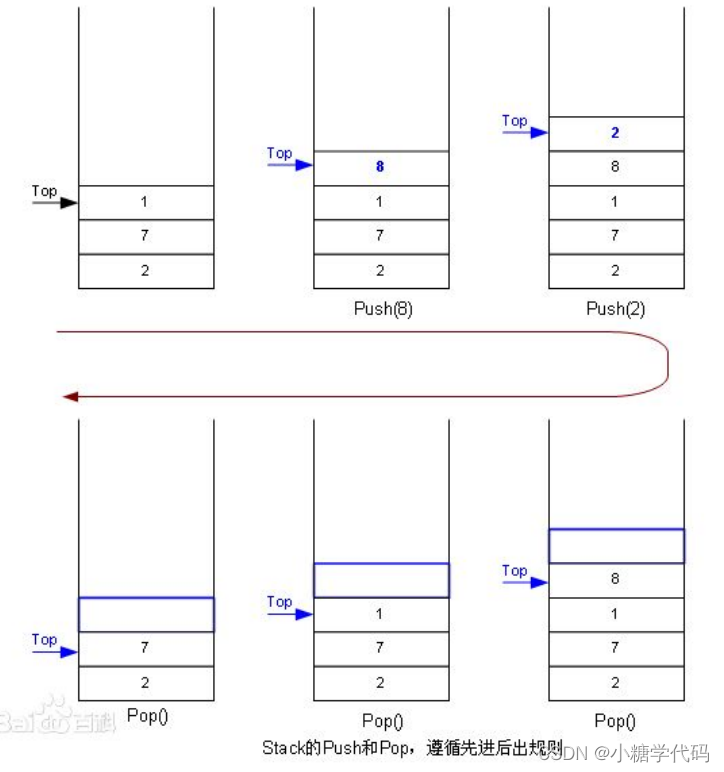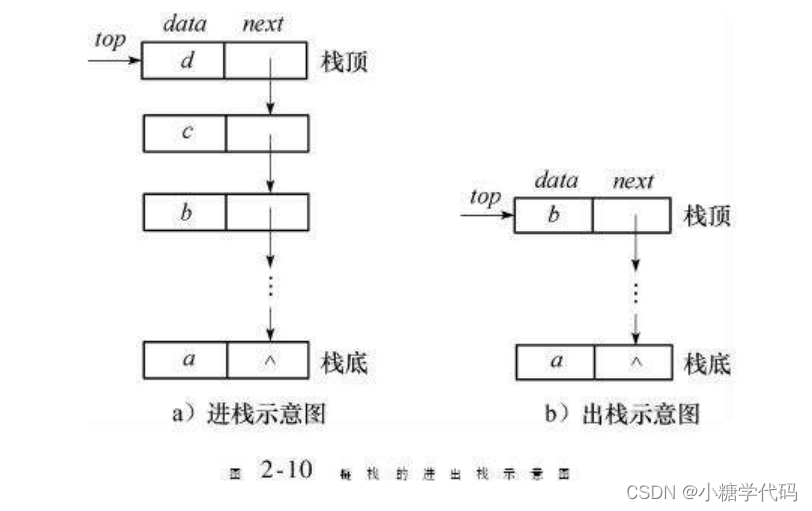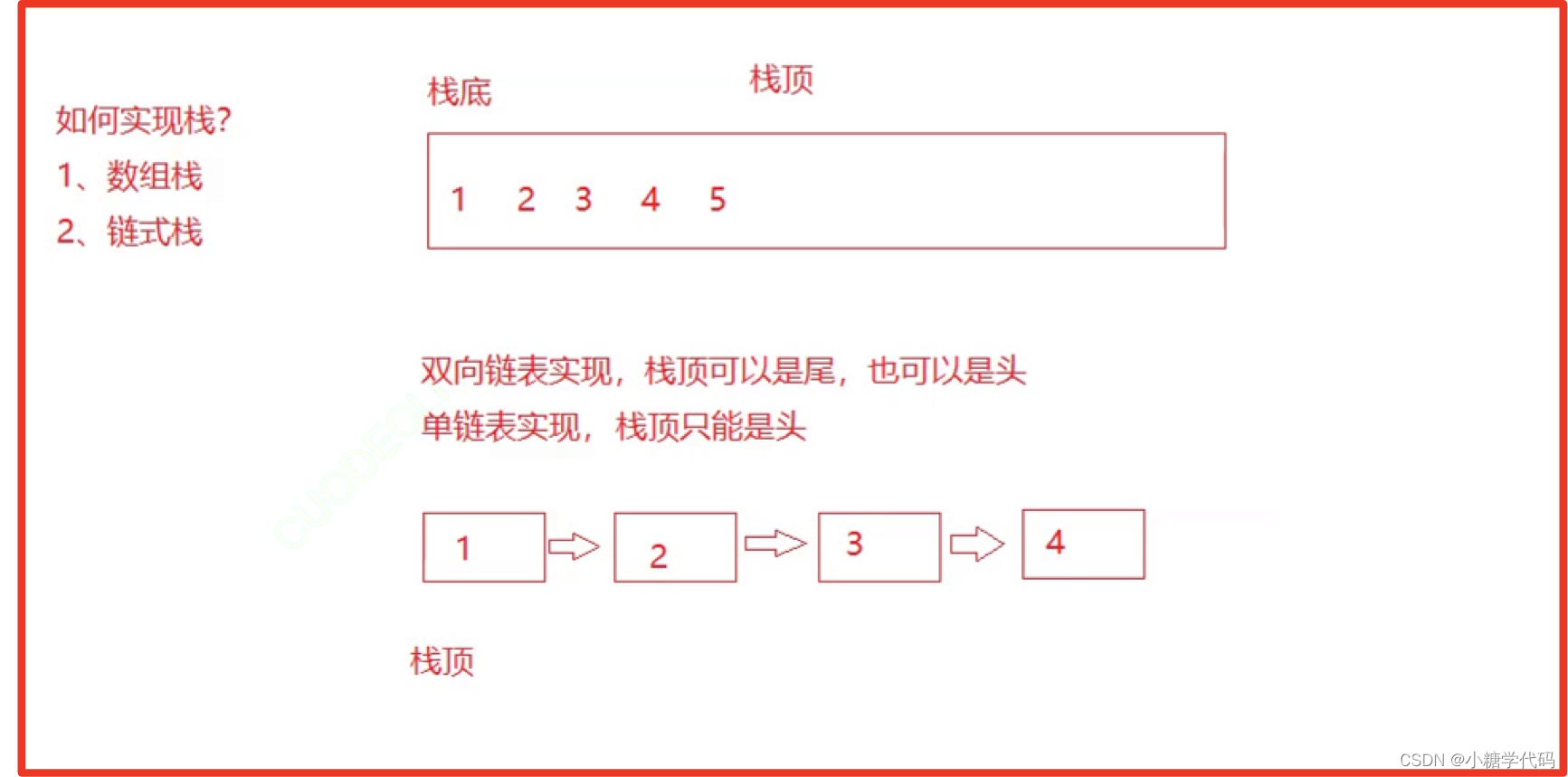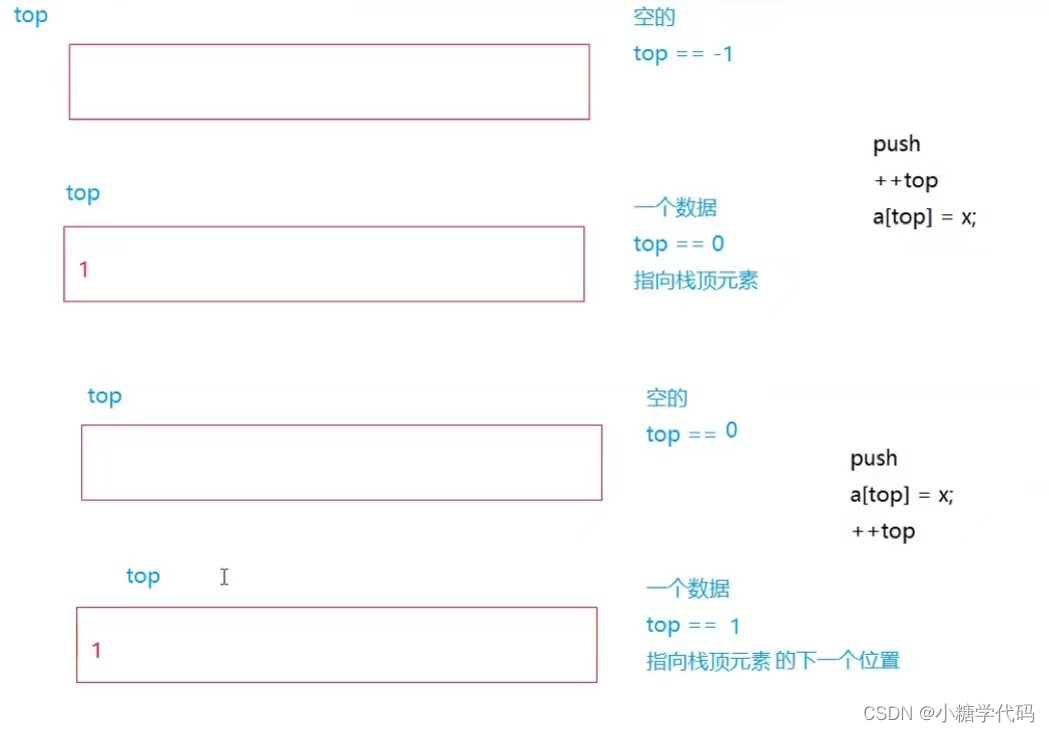栈和队列
一.栈
1. 栈的概念及结构
- 栈:一种特殊的线性表,其只允许在固定的一端进行插入和删除元素操作。**进行数据插入和删除操作的一端称为栈顶,另一端称为栈底。**栈中的数据元素遵守后进先出LIFO(Last In First Out)的原则。
- 压栈:栈的插入操作叫做进栈/压栈/入栈,入数据在栈顶。
- 出栈:栈的删除操作叫做出栈。出数据也在栈顶。


2. 栈的实现
栈的实现一般可以使用数组或者链表实现,相对而言数组的结构实现更优一些。因为数组在尾上插入数据的代价比较小。



// 下面是定长的静态栈的结构,实际中一般不实用,所以我们主要实现下面的支持动态增长的栈
typedef int STDataType;
#define N 10
typedef struct Stack
{STDataType _a[N];int _top; // 栈顶
}Stack;
// 支持动态增长的栈
typedef int STDataType;
typedef struct Stack
{STDataType* _a;int _top; // 栈顶int _capacity; // 容量
}Stack;
// 初始化栈
void StackInit(Stack* ps);
// 入栈
void StackPush(Stack* ps, STDataType data);
// 出栈
void StackPop(Stack* ps);
// 获取栈顶元素
STDataType StackTop(Stack* ps);
// 获取栈中有效元素个数
int StackSize(Stack* ps);
// 检测栈是否为空,如果为空返回非零结果,如果不为空返回0
int StackEmpty(Stack* ps);
// 销毁栈
void StackDestroy(Stack* ps);
//栈的实现
typedef int STDataType;typedef struct Stack
{STDataType* a;int top; // 标识栈顶位置的int capacity;
}ST;void STInit(ST* pst)
{assert(pst);pst->a = NULL;pst->capacity = 0;// 表示top指向栈顶元素的下一个位置pst->top = 0;// 表示top指向栈顶元素//pst->top = -1;
}void STDestroy(ST* pst)
{assert(pst);free(pst->a);pst->a = NULL;pst->top = pst->capacity = 0;
}// 栈顶插入删除
void STPush(ST* pst, STDataType x)
{assert(pst);if (pst->top == pst->capacity){int newcapacity = pst->capacity == 0 ? 4 : pst->capacity * 2;STDataType* tmp = (STDataType*)realloc(pst->a, sizeof(STDataType) * newcapacity);if (tmp == NULL){perror("realloc fail");return;}pst->a = tmp;pst->capacity = newcapacity;}pst->a[pst->top] = x;pst->top++;
}void STPop(ST* pst)
{assert(pst);// 不为空assert(pst->top > 0);pst->top--;
}STDataType STTop(ST* pst)
{assert(pst);// 不为空assert(pst->top > 0);return pst->a[pst->top - 1];
}bool STEmpty(ST* pst)
{assert(pst);/*if (pst->top == 0){return true;}else{return false;}*/return pst->top == 0;
}int STSize(ST* pst)
{assert(pst);return pst->top;
}
- 注意:

二.队列
1. 队列的概念及结构
队列:只允许在一端进行插入数据操作,在另一端进行删除数据操作的特殊线性表,队列具有先进先出FIFO(First In First Out) 入队列:进行插入操作的一端称为队尾出队列:进行删除操作的一端称为队头

2. 队列的实现
队列也可以数组和链表的结构实现,使用链表的结构实现更优一些,因为如果使用数组的结构,出队列在数组头上出数据,效率会比较低。

// 链式结构:表示队列
typedef struct QListNode
{ struct QListNode* _pNext; QDataType _data;
}QNode;
// 队列的结构
typedef struct Queue
{ QNode* _front; QNode* _rear;
}Queue;
// 初始化队列
void QueueInit(Queue* q);
// 队尾入队列
void QueuePush(Queue* q, QDataType data);
// 队头出队列
void QueuePop(Queue* q);
// 获取队列头部元素
QDataType QueueFront(Queue* q);
// 获取队列队尾元素
QDataType QueueBack(Queue* q);
// 获取队列中有效元素个数
int QueueSize(Queue* q);
// 检测队列是否为空,如果为空返回非零结果,如果非空返回0
int QueueEmpty(Queue* q);
// 销毁队列
void QueueDestroy(Queue* q);
//队列的实现
typedef int QDataType;
typedef struct QueueNode
{QDataType val;struct QueueNode* next;
}QNode;typedef struct Queue
{QNode* phead;QNode* ptail;int size;
}Queue;
void QueueInit(Queue* pq)
{assert(pq);pq->phead = pq->ptail = NULL;pq->size = 0;
}void QueueDestroy(Queue* pq)
{assert(pq);QNode* cur = pq->phead;while (cur){QNode* next = cur->next;free(cur);cur = next;}pq->phead = pq->ptail = NULL;pq->size = 0;
}void QueuePush(Queue* pq, QDataType x)
{assert(pq);QNode* newnode = (QNode*)malloc(sizeof(QNode));if (newnode == NULL){perror("malloc fail");return;}newnode->val = x;newnode->next = NULL;if (pq->ptail == NULL){pq->ptail = pq->phead = newnode;}else{pq->ptail->next = newnode;pq->ptail = newnode;}pq->size++;
}void QueuePop(Queue* pq)
{assert(pq);assert(pq->phead);QNode* del = pq->phead;pq->phead = pq->phead->next;free(del);del = NULL;if (pq->phead == NULL)pq->ptail = NULL;pq->size--;
}QDataType QueueFront(Queue* pq)
{assert(pq);assert(pq->phead);return pq->phead->val;
}QDataType QueueBack(Queue* pq)
{assert(pq);assert(pq->ptail);return pq->ptail->val;
}bool QueueEmpty(Queue* pq)
{assert(pq);return pq->phead == NULL;
}int QueueSize(Queue* pq)
{assert(pq);return pq->size;
}
三.栈和队列面试题
1. 有效的括号
https://leetcode.cn/problems/valid-parentheses/description/
typedef char STDataType;typedef struct Stack
{STDataType* a;int top; //标识栈顶位置的int capacity;
}ST;void STInit(ST* pst);
void STDetory(ST* pst);
void STPush(ST* pst, STDataType x);
void STPop(ST* pst);
STDataType STTop(ST* pst);
bool STEmpty(ST* pst);
int STSize(ST* pst);void STInit(ST* pst)
{assert(pst);pst->a = NULL;pst->capacity = 0;// 表示top指向栈顶元素的下一个位置pst->top = 0;// 表示top指向栈顶元素//pst->top = -1;
}void STDestroy(ST* pst)
{assert(pst);free(pst->a);pst->a = NULL;pst->top = pst->capacity = 0;
}void STPush(ST* pst, STDataType x)
{assert(pst);if (pst->top == pst->capacity){int newcapacity = pst->capacity == 0 ? 4 : pst->capacity * 2;STDataType* tmp = (STDataType*)realloc(pst->a, sizeof(STDataType) * newcapacity);if (tmp == NULL){perror("realloc fail");return;}pst->a = tmp;pst->capacity = newcapacity;}pst->a[pst->top] = x;pst->top++;
}void STPop(ST* pst)
{assert(pst);assert(pst->top > 0);pst->top--;
}STDataType STTop(ST* pst)
{assert(pst);assert(pst->top > 0);return pst->a[pst->top - 1];
}bool STEmpty(ST* pst)
{assert(pst);return pst->top == 0;
}int STSize(ST* pst)
{assert(pst);return pst->top;
}bool isValid(char* s) {ST st;STInit(&st);while(*s){//顺序不匹配if(*s=='('||*s=='['||*s=='{'){STPush(&st,*s);}else{if(st.top==0){STDestroy(&st);return false;}char top=STTop(&st);STPop(&st);if(*s==')'&&top!='('||*s==']'&&top!='['||*s=='}'&&top!='{'){STDestroy(&st);return false;}}s++;}if(st.top!=0){STDestroy(&st);return false;}STDestroy(&st);return true;
}
2. 用队列实现栈
https://leetcode.cn/problems/implement-stack-using-queues/description/
-
- 一个队列存数据
-
- 另一个队列用来出数据时,导数据
typedef int QDataType;
typedef struct QueueNode
{QDataType val;struct QueueNode* next;
}QNode;typedef struct Queue
{QNode* phead;QNode* ptail;int size;
}Queue;void QueueInit(Queue* pq);
void QueueDestroy(Queue* pq);
void QueuePush(Queue* pq, QDataType x);
void QueuePop(Queue* pq);
QDataType QueueFront(Queue* pq);
QDataType QueueBack(Queue* pq);
bool QueueEmpty(Queue* pq);
int QueueSize(Queue* pq);void QueueInit(Queue* pq)
{assert(pq);pq->phead = pq->ptail = NULL;pq->size = 0;
}void QueueDestroy(Queue* pq)
{assert(pq);QNode* cur = pq->phead;while (cur){QNode* next = cur->next;free(cur);cur = next;}pq->phead = pq->ptail = NULL;pq->size = 0;
}void QueuePush(Queue* pq, QDataType x)
{assert(pq);QNode* newnode = (QNode*)malloc(sizeof(QNode));if (newnode == NULL){perror("malloc fail");return;}newnode->val = x;newnode->next = NULL;if (pq->ptail == NULL){pq->ptail = pq->phead = newnode;}else{pq->ptail->next = newnode;pq->ptail = newnode;}pq->size++;
}void QueuePop(Queue* pq)
{assert(pq);assert(pq->phead);QNode* del = pq->phead;pq->phead = pq->phead->next;free(del);del = NULL;if (pq->phead == NULL)pq->ptail = NULL;pq->size--;
}QDataType QueueFront(Queue* pq)
{assert(pq);assert(pq->phead);return pq->phead->val;
}QDataType QueueBack(Queue* pq)
{assert(pq);assert(pq->ptail);return pq->ptail->val;
}bool QueueEmpty(Queue* pq)
{assert(pq);return pq->phead == NULL;
}int QueueSize(Queue* pq)
{assert(pq);return pq->size;
}typedef struct {Queue q1;Queue q2;
} MyStack;MyStack* myStackCreate() {MyStack* pst=(MyStack*)malloc(sizeof(MyStack));QueueInit(&pst->q1);QueueInit(&pst->q2);return pst;
}void myStackPush(MyStack* obj, int x) {if(!QueueEmpty(&obj->q1)){QueuePush(&obj->q1,x);}else{QueuePush(&obj->q2,x);}
}int myStackPop(MyStack* obj) {Queue* emptyq=&obj->q1;Queue* nonemptyq=&obj->q2;if(!QueueEmpty(&obj->q1)){emptyq=&obj->q2;nonemptyq=&obj->q1;}while(QueueSize(nonemptyq)>1){QueuePush(emptyq,QueueFront(nonemptyq));QueuePop(nonemptyq);}int top=QueueFront(nonemptyq);QueuePop(nonemptyq);return top;
}int myStackTop(MyStack* obj) {if(!QueueEmpty(&obj->q1)){return QueueBack(&obj->q1);}else{return QueueBack(&obj->q2);}
}bool myStackEmpty(MyStack* obj) {return QueueEmpty(&obj->q1)&&QueueEmpty(&obj->q2);
}void myStackFree(MyStack* obj) {QueueDestroy(&obj->q1);QueueDestroy(&obj->q2);free(obj);
}/*** Your MyStack struct will be instantiated and called as such:* MyStack* obj = myStackCreate();* myStackPush(obj, x);* int param_2 = myStackPop(obj);* int param_3 = myStackTop(obj);* bool param_4 = myStackEmpty(obj);* myStackFree(obj);
*/
3. 用栈实现队列
https://leetcode.cn/problems/implement-queue-using-stacks/
//法一:
typedef int STDataType;typedef struct Stack
{STDataType* a;int top; // 标识栈顶位置的int capacity;
}ST;void STInit(ST* pst);
void STDestroy(ST* pst);// 栈顶插入删除
void STPush(ST* pst, STDataType x);
void STPop(ST* pst);
STDataType STTop(ST* pst);bool STEmpty(ST* pst);
int STSize(ST* pst);void STInit(ST* pst)
{assert(pst);pst->a = NULL;pst->capacity = 0;// 表示top指向栈顶元素的下一个位置pst->top = 0;// 表示top指向栈顶元素//pst->top = -1;
}void STDestroy(ST* pst)
{assert(pst);free(pst->a);pst->a = NULL;pst->top = pst->capacity = 0;
}// 栈顶插入删除
void STPush(ST* pst, STDataType x)
{assert(pst);if (pst->top == pst->capacity){int newcapacity = pst->capacity == 0 ? 4 : pst->capacity * 2;STDataType* tmp = (STDataType*)realloc(pst->a, sizeof(STDataType) * newcapacity);if (tmp == NULL){perror("realloc fail");return;}pst->a = tmp;pst->capacity = newcapacity;}pst->a[pst->top] = x;pst->top++;
}void STPop(ST* pst)
{assert(pst);// 不为空assert(pst->top > 0);pst->top--;
}STDataType STTop(ST* pst)
{assert(pst);// 不为空assert(pst->top > 0);return pst->a[pst->top - 1];
}bool STEmpty(ST* pst)
{assert(pst);/*if (pst->top == 0){return true;}else{return false;}*/return pst->top == 0;
}int STSize(ST* pst)
{assert(pst);return pst->top;
}typedef struct {ST q1;ST q2;
} MyQueue;MyQueue* myQueueCreate() {MyQueue* pst=(MyQueue*)malloc(sizeof(MyQueue));STInit(&pst->q1);STInit(&pst->q2);return pst;
}void myQueuePush(MyQueue* obj, int x) {if(!STEmpty(&obj->q1)){STPush(&obj->q1,x);}else{STPush(&obj->q2,x);}
}int myQueuePop(MyQueue* obj) {ST* emptyq=&obj->q1;ST* nonemptyq=&obj->q2;if(!STEmpty(&obj->q1)){emptyq=&obj->q2;nonemptyq=&obj->q1;}while(STSize(nonemptyq)>0){STPush(emptyq,STTop(nonemptyq));STPop(nonemptyq);}int top =STTop(emptyq);STPop(emptyq);while(STSize(emptyq)>0){STPush(nonemptyq,STTop(emptyq));STPop(emptyq);}return top;
}int myQueuePeek(MyQueue* obj) {ST* emptyq=&obj->q1;ST* nonemptyq=&obj->q2;if(!STEmpty(&obj->q1)){emptyq=&obj->q2;nonemptyq=&obj->q1;}while(STSize(nonemptyq)>0){STPush(emptyq,STTop(nonemptyq));STPop(nonemptyq);}int top =STTop(emptyq);while(STSize(emptyq)>0){STPush(nonemptyq,STTop(emptyq));STPop(emptyq);}return top;
}bool myQueueEmpty(MyQueue* obj) {return STEmpty(&obj->q1)&&STEmpty(&obj->q2);
}void myQueueFree(MyQueue* obj) {STDestroy(&obj->q1);STDestroy(&obj->q2);free(obj);
}/*** Your MyQueue struct will be instantiated and called as such:* MyQueue* obj = myQueueCreate();* myQueuePush(obj, x);* int param_2 = myQueuePop(obj);* int param_3 = myQueuePeek(obj);* bool param_4 = myQueueEmpty(obj);* myQueueFree(obj);
*/
//法二:
typedef int STDataType;typedef struct Stack
{STDataType* a;int top; // 标识栈顶位置的int capacity;
}ST;void STInit(ST* pst);
void STDestroy(ST* pst);// 栈顶插入删除
void STPush(ST* pst, STDataType x);
void STPop(ST* pst);
STDataType STTop(ST* pst);bool STEmpty(ST* pst);
int STSize(ST* pst);void STInit(ST* pst)
{assert(pst);pst->a = NULL;pst->capacity = 0;// 表示top指向栈顶元素的下一个位置pst->top = 0;// 表示top指向栈顶元素//pst->top = -1;
}void STDestroy(ST* pst)
{assert(pst);free(pst->a);pst->a = NULL;pst->top = pst->capacity = 0;
}// 栈顶插入删除
void STPush(ST* pst, STDataType x)
{assert(pst);if (pst->top == pst->capacity){int newcapacity = pst->capacity == 0 ? 4 : pst->capacity * 2;STDataType* tmp = (STDataType*)realloc(pst->a, sizeof(STDataType) * newcapacity);if (tmp == NULL){perror("realloc fail");return;}pst->a = tmp;pst->capacity = newcapacity;}pst->a[pst->top] = x;pst->top++;
}void STPop(ST* pst)
{assert(pst);// 不为空assert(pst->top > 0);pst->top--;
}STDataType STTop(ST* pst)
{assert(pst);// 不为空assert(pst->top > 0);return pst->a[pst->top - 1];
}bool STEmpty(ST* pst)
{assert(pst);/*if (pst->top == 0){return true;}else{return false;}*/return pst->top == 0;
}int STSize(ST* pst)
{assert(pst);return pst->top;
}typedef struct {ST pushst;ST popst;
} MyQueue;MyQueue* myQueueCreate() {MyQueue* pst=(MyQueue*)malloc(sizeof(MyQueue));STInit(&pst->pushst);STInit(&pst->popst);return pst;
}void myQueuePush(MyQueue* obj, int x) {STPush(&obj->pushst,x);
}int myQueuePop(MyQueue* obj) {int top;if(!STEmpty(&obj->popst)){top =STTop(&obj->popst);STPop(&obj->popst);}else{while(STSize(&obj->pushst)>0){STPush(&obj->popst,STTop(&obj->pushst));STPop(&obj->pushst);}top =STTop(&obj->popst);STPop(&obj->popst);}return top;
}int myQueuePeek(MyQueue* obj) {int top;if(!STEmpty(&obj->popst)){top =STTop(&obj->popst);}else{while(STSize(&obj->pushst)>0){STPush(&obj->popst,STTop(&obj->pushst));STPop(&obj->pushst);}top =STTop(&obj->popst);}return top;
}bool myQueueEmpty(MyQueue* obj) {return STEmpty(&obj->pushst)&&STEmpty(&obj->popst);
}void myQueueFree(MyQueue* obj) {STDestroy(&obj->pushst);STDestroy(&obj->popst);free(obj);
}/*** Your MyQueue struct will be instantiated and called as such:* MyQueue* obj = myQueueCreate();* myQueuePush(obj, x);* int param_2 = myQueuePop(obj);* int param_3 = myQueuePeek(obj);* bool param_4 = myQueueEmpty(obj);* myQueueFree(obj);
*/
4. 设计循环队列
https://leetcode.cn/problems/design-circular-queue/description/
typedef struct {int* a;int front;int back;int k;
} MyCircularQueue;bool myCircularQueueIsEmpty(MyCircularQueue* obj);
bool myCircularQueueIsFull(MyCircularQueue* obj);MyCircularQueue* myCircularQueueCreate(int k) {MyCircularQueue* obj=(MyCircularQueue*)malloc(sizeof(MyCircularQueue));obj->a=(int*)malloc(sizeof(int*)*(k+1));obj->front=0;obj->back=0;obj->k=k;return obj;
}bool myCircularQueueEnQueue(MyCircularQueue* obj, int value) {if(myCircularQueueIsFull(obj)){return false;}obj->a[obj->back]=value;obj->back=(obj->back+1)%(obj->k+1);return true;
}bool myCircularQueueDeQueue(MyCircularQueue* obj) {if(myCircularQueueIsEmpty(obj)){return false;}obj->front=(obj->front+1)%(obj->k+1);return true;
}int myCircularQueueFront(MyCircularQueue* obj) {if(myCircularQueueIsEmpty(obj)){return -1;}return obj->a[obj->front];}int myCircularQueueRear(MyCircularQueue* obj) {if(myCircularQueueIsEmpty(obj)){return -1;}if(obj->back==0){return obj->a[obj->k];}else{return obj->a[obj->back-1];}
}bool myCircularQueueIsEmpty(MyCircularQueue* obj) {return obj->front==obj->back;
}bool myCircularQueueIsFull(MyCircularQueue* obj) {return (obj->back+1)%(obj->k+1)==obj->front;
}void myCircularQueueFree(MyCircularQueue* obj) {free(obj->a);free(obj);
}/*** Your MyCircularQueue struct will be instantiated and called as such:* MyCircularQueue* obj = myCircularQueueCreate(k);* bool param_1 = myCircularQueueEnQueue(obj, value);* bool param_2 = myCircularQueueDeQueue(obj);* int param_3 = myCircularQueueFront(obj);* int param_4 = myCircularQueueRear(obj);* bool param_5 = myCircularQueueIsEmpty(obj);* bool param_6 = myCircularQueueIsFull(obj);* myCircularQueueFree(obj);
*/
- 优化写法

---- flask初始及创建登录页面)


)







: HTML解释器和DOM 模型)
第2版 例4-5 select)
 缓存约束的数据结构】)

-UDP协议详解)

)

